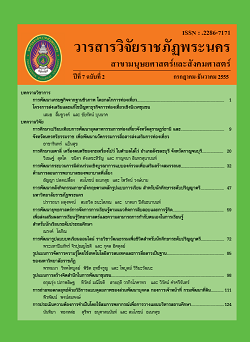การพัฒนากระบวนการมีส่วนร่วมเชิงบูรณาการแบบองค์รวม เพื่อเสริมสร้างสมรรถนะด้านการสอนการพยาบาลของพยาบาลพี่เลี้ยง
Main Article Content
Abstract
การวิจัยนี้มีวัตถุประสงค์เพื่อ 1. ศึกษาสมรรถนะด้านการสอนการพยาบาลของพยาบาลพี่เลี้ยง 2. สังเคราะห์องค์ประกอบสมรรถนะด้านการสอนการพยาบาลของพยาบาลพี่เลี้ยงจากประสบการณ์การปฏิบัติ ในสภาพที่เป็นจริง 3. วิเคราะห์องค์ประกอบเชิงยืนยันสมรรถนะด้านการสอนการพยาบาลของพยาบาลพี่เลี้ยง 4. พัฒนากระบวนการมีส่วนร่วมเชิงบูรณาการแบบองค์รวมเพื่อเสริมสร้างสมรรถนะด้านการสอนการ พยาบาลของพยาบาลพี่เลี้ยง และ 5. พัฒนาคู่มือเสริมสร้างสมรรถนะด้านการสอนการพยาบาลของพยาบาล พี่เลี้ยง ใช้การวิจัยแบบผสม ได้แก่ การวิจัยเชิงคุณภาพด้วยวิธีการวิจัยเชิงปรากฏการณ์วิทยาการตีความ ตาม แนวคิดของมาร์ติน ไฮเดกเกอร์ ผู้ให้ข้อมูลแบบเจาะจง จำนวน 3 กลุ่ม ได้แก่ พยาบาลพี่เลี้ยง 18 คน อาจารย์ พยาบาล 10 คน และนักศึกษาพยาบาล 15 คน ใช้วิธีสัมภาษณ์แบบเจาะลึก และการสัมภาษณ์กลุ่ม วิเคราะห์ ข้อมูลด้วยวิธีของไมล์และฮิวเบอร์แมน และนำข้อมูลที่ได้มาหาข้อสรุป เชื่อมโยงโดยใช้แผนภูมิมโนทัศน์ เพื่อ กำหนดองค์ประกอบและใช้การวิจัยเชิงปริมาณด้วยการวิเคราะห์องค์ประกอบเชิงยืนยัน กลุ่มตัวอย่างเป็น พยาบาลพี่เลี้ยงที่ทำงานในโรงพยาบาลสังกัดกระทรวงสาธารณสุข 396 คน อาจารย์พยาบาลที่ทำงานใน วิทยาลัยพยาบาลสังกัดกระทรวงสาธารณสุขจำนวน 139 คน รวม 535 คน รวบรวมข้อมูลโดยใช้แบบสอบถาม ที่มีค่าความเชื่อมั่น () .98 วิเคราะห์ข้อมูลเชิงบรรยายใช้โปรแกรมประมวลผลสถิติ ผลการวิจัยพบว่า
1. สมรรถนะด้านการสอนการพยาบาลที่พึงประสงค์ของพยาบาลพี่เลี้ยงประกอบด้วย ทักษะ ปฏิสัมพันธ์ระหว่างบุคคล ทักษะความรู้ความสามารถทางการพยาบาล และทักษะบูรณาการการสอน การพยาบาล
2. องค์ประกอบสมรรถนะการสอนการพยาบาลของพยาบาลพี่เลี้ยงในสภาพที่เป็นจริง ประกอบด้วย ทักษะปฏิสัมพันธ์ระหว่างบุคคล ทักษะความรู้ความสามารถทางการพยาบาล และทักษะบูรณาการการสอน การพยาบาล
3. โมเดลองค์ประกอบสมรรถนะการสอนการพยาบาลของพยาบาลพี่เลี้ยง ประกอบด้วย ตัวแปรแฝง 3 ตัว คือ ทักษะปฏิสัมพันธ์ระหว่างบุคคล ทักษะความรู้ความสามารถทางการพยาบาล และทักษะบูรณาการการสอนการพยาบาล มีตัวแปรสังเกตได้ 8 ตัว คือ ทักษะปฏิสัมพันธ์ระหว่างบุคคลด้านบุคลิกภาพ ทักษะปฏิสัมพันธ์ระหว่างบุคคลด้านคุณธรรมจริยธรรม ทักษะปฏิสัมพันธ์ระหว่างบุคคลด้านทัศนคติ ทักษะ ความรู้ความสามารถทางการพยาบาลด้านองค์ความรู้ทางการพยาบาล ทักษะความรู้ความสามารถทางการ พยาบาลด้านทักษะการปฏิบัติการพยาบาลผู้ป่วย ทักษะบูรณาการด้านการสอนกับการพยาบาล ด้านการใช้ ทฤษฎีร่วมกับประสบการณ์ในการสอนการพยาบาล ทักษะบูรณาการการสอนการพยาบาลด้านการวัดประเมิน ผลการฝึกงาน และทักษะบูรณาการการสอนการพยาบาลด้านทักษะการคิด เป็นโมเดลที่มีความสอดคล้อง กลมกลืนกับข้อมูลเชิงประจักษ์ โดยมีค่าไค–สแควร์ = 19.30 ที่องศาอิสระ =18 ค่าความน่าจะเป็น = .373, GFI = .931, AGFI = .854 และ RMR = 0.032
4. กระบวนการมีส่วนร่วมเชิงบูรณาการแบบองค์รวม พัฒนาขึ้นจากองค์ประกอบสมรรถนะการสอน การพยาบาลของพยาบาลพี่เลี้ยง ตามกระบวนการ A-I-C โดยการร่วมระดมกำลังสมองจากพยาบาลพี่เลี้ยง และอาจารย์พยาบาล จำนวน 14 คน
5. คู่มือเสริมสร้างสมรรถนะการสอนการพยาบาลของพยาบาลพี่เลี้ยง ได้รับการพัฒนา และ ตรวจสอบจากผู้เชี่ยวชาญจำนวน 4 คน เพื่อนำไปใช้พัฒนาพยาบาลพี่เลี้ยงให้มีสมรรถนะตรงกับคุณลักษณะ ที่พึงประสงค์
ทั้งรูปแบบกระบวนการการมีส่วนร่วมเชิงบูรณาการแบบองค์รวม และคู่มือเสริมสร้างสมรรถนะการ สอนการพยาบาลของพยาบาลพี่เลี้ยงที่ได้จากการวิจัย สามารถนำไปใช้พัฒนาสมรรถนะด้านการสอนการ พยาบาลของพยาบาลพี่เลี้ยงได้เป็นอย่างดี
A Development of Holistic and Participatory Integrative Process to Enhance Competencies in Nursing Teaching of Preceptor Nurses
The purposes of this research were to (1) examine teaching competencies of preceptor nurses, (2) synthesize factors affecting teaching competencies of the preceptor nurses in real situations, (3) identify confirmatory factors affecting teaching competencies of preceptor nurses, (4) develop the holistic and participatory process to enhance teaching competencies of the preceptor nurses, and (5) construct guidelines on enhancement teaching competencies of preceptor nurses. This research incorporated mixed methods, i.e. qualitative and quantitative approaches. As for the qualitative approach, Heidegger’s hermeneutic phenomenology technique was employed. The data were collected from three groups of respondents, namely 18 preceptor nurses, 10 nurse teachers, and 15 nursing students. The research instruments were in-depth interviews and focus group discussions. The data were analyzed by using Miles & Huberman. The findings were presented through a mind map. The quantitative approach was employed in the confirmatory factor analysis. The sample was 535 respondents comprised of 396 preceptor nurses working in hospitals under MOPH, 139 nurse teachers working in nurse colleges under MOPH. The data was collected by using a questionnaire with a reliability of .98, calculated by using Cronbach’s alpha coefficient. The data analysis was performed through descriptive statistics, by using a statistic program.
The findings were as follows:
1. Preceptor nurses’ teaching competencies consisted of interpersonal skills, nursing knowledge, and integrative teaching skills.
2. Factors affecting teaching competencies of the preceptor nurses in real situations were interpersonal skills, nursing knowledge, and integrative teaching skills.
3. The model of teaching competencies of preceptor nurses was comprised of three latent variables i.e. interpersonal skills, nursing knowledge, and integrative teaching skills; and eight observed variables i.e. three of interpersonal skills, namely personality, virtue morality, attitudes; and five of integrative teaching skills, namely nursing knowledge, nursing practice skills, integrative teaching skills, teaching based on theories and hands-experience, assessment and evaluation, and thinking skills. The model was consistent with empirical findings. The validity of the fitted model yielded a chi-square of 19.30 at a degree of freedom of 18; df 37; GFI .93, AGFI 8.5, and RMR 0.03.
4. The holistic and participatory process was developed from factors affecting teaching competencies of preceptor nurses by the A-I-C process and a brainstorming session in which 14 preceptor nurses and nursing instructors participated.
5. The guidelines on teaching competency enhancement for preceptor nurses were developed and examined by 4 nursing experts. The guidelines were intended to help develop teaching competencies to accord with desirable traits of preceptor nurses.
The holistic and participatory process and the guidelines, derived from this research, were effectively implemented on teaching competency enhancement for preceptor nurses.
Article Details
Each publish articles were copyright by Phranakorn Rajabhat University
Any contents which appeared in each articles in the journal were authors personal opinion. It did not relate to Phranakorn Rajabhat University and other instructors in the university. Each authors would take responsibility on their articles. If there are any mistake, the authors will take responsibility themselves


